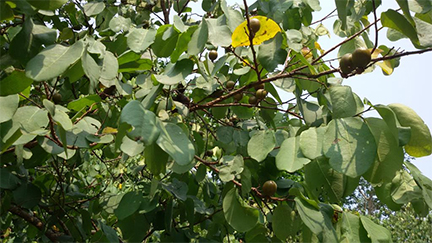Social Justice
Kendu Leaf
- 30 Jul 2021
- 4 min read
Why in News
Recently, several children were seen collecting kendu (Tendu) leaves in Odisha’s Kalahandi district.
Key Points
- About:
- Kendu leaf is called the green gold of Odisha. It is a nationalised product like bamboo and sal seed. It is one of the most important non-wood forest products in Odisha.
- Botanical name of the Tendu (Kendu) leaf is Diospyros Melanoxylon.
- The leaves are used to wrap bidis, a popular smoke among the locals.
- Kendu leaf is called the green gold of Odisha. It is a nationalised product like bamboo and sal seed. It is one of the most important non-wood forest products in Odisha.
- States Producing Kendu Leaves:
- The states producing bidi leaves in India comprises mainly Madhya Pradesh, Chhattisgarh, Odisha, Andhra Pradesh, Jharkhand, Gujarat and Maharashtra.
- Odisha is the third-largest producer of kendu leaf, after Madhya Pradesh and Chhattisgarh.
- The states producing bidi leaves in India comprises mainly Madhya Pradesh, Chhattisgarh, Odisha, Andhra Pradesh, Jharkhand, Gujarat and Maharashtra.
- Uniqueness:
- The Uniqueness of Odisha's Tendu (kendu) leaf is in processed form whereas the rest of the states in India produce in Phal Form.
- In processed form the Kendu leafs are graded into different qualities that are Grade I to Grade IV as per the specification of color, texture, size and body condition of the leaf and packets will be done by taking Five Kilograms as a Bundle.
- The Uniqueness of Odisha's Tendu (kendu) leaf is in processed form whereas the rest of the states in India produce in Phal Form.
- Significance:
- Medicament:
- Traditional medical practitioners use these tiny fruits of Kendu to treat malaria, diarrhoea and dysentery.
- Due to their antimicrobial properties, the leaves are applied on cuts and bruises as well.
- Source of Livelihood:
- Kendu leaves are the major source for tribal villages, since it is the most prominent Minor Forest Produce of the state.
- MFP includes all non-timber forest produce of plant origin and includes bamboo, canes, fodder, leaves, gums, waxes, dyes, resins and many forms of food including nuts, wild fruits, honey, lac, tusser etc.
- They form a major portion of their food, fruits, medicines and other consumption items and also provide cash income through sales.
- Kendu leaves are the major source for tribal villages, since it is the most prominent Minor Forest Produce of the state.
- Major Part in Odisha’s Forest Revenue:
- Of Odisha’s total forest revenue of Rs 868 million in 1990-2000, kendu leaves alone account for Rs 635 million.
- The annual production of bidi leaf in Odisha is around 4.5-5 lakh a quintal, which is about 20% of the county’s annual production.
- Medicament:
- Concern:
- Low Wage:
- Children working at kendu leaf collection centres often step in during April-May every year. They mostly engaged in plucking, drying, collecting, etc. They are paid extremely low wages for the work.
- Exploitation of Children:
- Children below 14 years can not be engaged as workers and between 14-18 years can only be engaged in non hazardous sectors.
- In such a scenario they are exploited.
- Low Wage:
Way Forward
- To free this sector from child labour, more stringent laws are needed. Parents and children need to be sensitised about child rights.
- Besides the child protection system viz. childline, district child protection unit, child welfare committee etc. would have to be more vigil and proactive in ensuring rights to children.
- Since the kendu leaf is a significant part of the forest economy of rural societies, there needs to be the deregulation of minor forest products so that tribal and rural people can exercise their rights on MFP.







